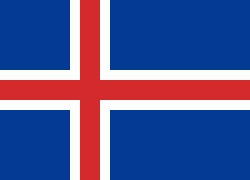Flag of Iceland
The flag of Iceland (íslenski fáninn) was officially described in Law No. 34, set out on 17 June 1944, the day Iceland became a republic. The law is entitled "The Law of the National Flag of Icelanders and the State Arms" and describes the Icelandic flag as follows:
"The civil national flag of Icelanders is blue as the sky with a snow-white cross, and a fiery-red cross inside the white cross. The arms of the cross extend to the edge of the flag, and their combined width is 2⁄9, but the red cross 1⁄9 of the combined width of the flag. The blue areas are right angled rectangles, the rectilinear surfaces are parallel and the outer rectilinear surfaces as wide as them, but twice the length. The dimensions between the width and length are 18:25."
Iceland's first national flag was a white cross on a deep blue background. It was first shown in parade in 1897. The modern flag dates from 1915, when a red cross was inserted into the white cross of the original flag. This cross represents Christianity. It was adopted and became the national flag when Iceland was granted sovereignty by Denmark in 1918. For the Icelandic people the flag's colouring represents a vision of their country's landscape. The colours stand for three of the elements that make up the island. Red is the fire produced by the island's volcanoes, white recalls the ice and snow that covers Iceland, and the blue is for the mountains of the island.
According to a legend described in Andrew Evans' Iceland, a red cloth with a white cross fell from the heavens, ensuring Danish victory at the Battle of Valdemar in the 13th century. Denmark then used the cross on its flag throughout its Nordic territories as a sign of divine right. Upon Iceland's independence, they continued to use the Christian symbol.
The civil flag of Iceland had been used as an unofficial symbol since 1913. It was officially adopted on 19 June 1915, to represent Iceland, and has been in use at sea since 1 December 1918, when Iceland became a separate Kingdom in union with Denmark. Other symbolic meanings refer to the natural features of Iceland itself. Blue is the colour of the mountains when looked at from the coast, white represents the snow and ice covering the island for most of the year, and red the volcanoes on the island.
"The civil national flag of Icelanders is blue as the sky with a snow-white cross, and a fiery-red cross inside the white cross. The arms of the cross extend to the edge of the flag, and their combined width is 2⁄9, but the red cross 1⁄9 of the combined width of the flag. The blue areas are right angled rectangles, the rectilinear surfaces are parallel and the outer rectilinear surfaces as wide as them, but twice the length. The dimensions between the width and length are 18:25."
Iceland's first national flag was a white cross on a deep blue background. It was first shown in parade in 1897. The modern flag dates from 1915, when a red cross was inserted into the white cross of the original flag. This cross represents Christianity. It was adopted and became the national flag when Iceland was granted sovereignty by Denmark in 1918. For the Icelandic people the flag's colouring represents a vision of their country's landscape. The colours stand for three of the elements that make up the island. Red is the fire produced by the island's volcanoes, white recalls the ice and snow that covers Iceland, and the blue is for the mountains of the island.
According to a legend described in Andrew Evans' Iceland, a red cloth with a white cross fell from the heavens, ensuring Danish victory at the Battle of Valdemar in the 13th century. Denmark then used the cross on its flag throughout its Nordic territories as a sign of divine right. Upon Iceland's independence, they continued to use the Christian symbol.
The civil flag of Iceland had been used as an unofficial symbol since 1913. It was officially adopted on 19 June 1915, to represent Iceland, and has been in use at sea since 1 December 1918, when Iceland became a separate Kingdom in union with Denmark. Other symbolic meanings refer to the natural features of Iceland itself. Blue is the colour of the mountains when looked at from the coast, white represents the snow and ice covering the island for most of the year, and red the volcanoes on the island.
National flag
Country - Iceland
Warning: getimagesize(/Image/Map/MP2629691.gif): failed to open stream: No such file or directory in /home/mapnlee7/public_html/MAPNALL/article.php on line 532
 |
 |
According to the ancient manuscript Landnámabók, the settlement of Iceland began in 874 AD when the Norwegian chieftain Ingólfr Arnarson became the first permanent settler on the island. In the following centuries, Norwegians, and to a lesser extent other Scandinavians, immigrated to Iceland, bringing with them thralls (i.e., slaves or serfs) of Gaelic origin.
